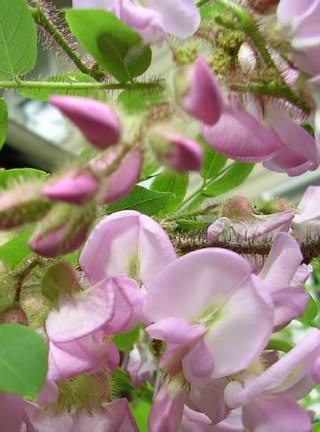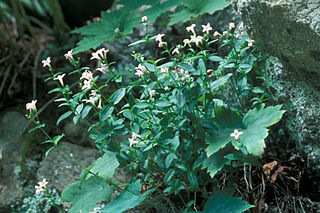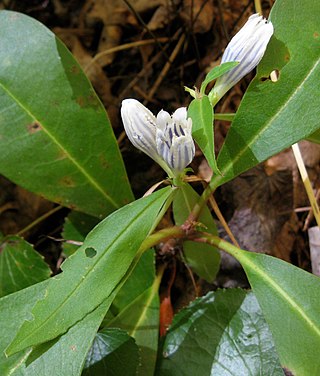
Trillium erectum, the red trillium, also known as wake robin, purple trillium, bethroot, or stinking benjamin, is a species of flowering plant in the family Melanthiaceae. The plant takes its common name "wake robin" by analogy with the European robin, which has a red breast heralding spring. Likewise Trillium erectum is a spring ephemeral plant whose life-cycle is synchronized with that of the forests in which it lives. It is native to the eastern United States and eastern Canada from northern Georgia to Quebec and New Brunswick.

Robinia hispida, known as the bristly locust, rose-acacia, or moss locust, is a shrub in the subfamily Faboideae of the pea family Fabaceae. It is native to the southeastern United States, and it is present in other areas, including other regions of North America, as an introduced species. It is grown as an ornamental and can escape cultivation and grow in the wild.

Rhododendron catawbiense, with common names Catawba rosebay, Catawba rhododendron, mountain rosebay, purple ivy, purple laurel, purple rhododendron, red laurel, rosebay, rosebay laurel, is a species of Rhododendron native to the eastern United States, growing mainly in the southern Appalachian Mountains from West Virginia south to northern Alabama.

Houstonia caerulea, commonly known as azure bluet, Quaker ladies, or bluets, is a perennial species in the family Rubiaceae. It is native to eastern Canada and the eastern United States. It is found in a variety of habitats such as cliffs, alpine zones, forests, meadows and shores of rivers or lakes.

Houstonia (bluet) is a genus of plants in the family Rubiaceae. Many species were formerly classified, along with other genera since segregated elsewhere, in a more inclusive genus Hedyotis.

Eurybia surculosa, commonly known as the creeping aster, is an herbaceous perennial in the family Asteraceae that was previously treated in the genus Aster. It is native to the eastern United States where it is found in sandy soils along the coastal plain, though when E. compacta is also present, it exists farther inland in the southern Appalachian Mountains and the Cumberland Plateau. Although the species is not seriously threatened, it is locally endangered in Virginia and Alabama. The flowers, which have bluish violet ray florets and pale yellow disc florets that eventually turn purplish, emerge in summer and persist into the fall.

Houstonia longifolia, commonly known as long-leaved bluet or longleaf summer bluet, is a perennial plant in the family Rubiaceae. It can be found throughout most of the Eastern United States and Canada. It has been reported from every state east of the Mississippi River except Delaware, plus North Dakota, Minnesota, Missouri, Arkansas and Oklahoma, with isolated populations in Kansas and Texas. Also, all Canadian provinces from Quebec to Alberta. It prefers upland woods in poor, dry, often sandy soil.

Solidago rugosa, commonly called the wrinkleleaf goldenrod or rough-stemmed goldenrod, is a species of flowering plant in the family Asteraceae. It is native to North America, where it is widespread across eastern and central Canada and the eastern and central United States. It is usually found in wet to mesic habitats.

Houstonia purpurea is a species of flowering plant in the coffee family known by the common names Venus's pride, woodland bluet, and purple bluet. It is native to the eastern United States from eastern Texas and Oklahoma east to Florida and Pennsylvania, with scattered populations in Nebraska, Iowa, Michigan, New York State and New England.

Clintonia umbellulata, commonly known as white clintonia or speckled wood-lily, is a species of flowering plant in the lily family Liliaceae. The specific epithet umbellulata means "umbelled," which refers to the shape of the plant’s inflorescence.
A cataract bog is a rare ecological community formed where a permanent stream flows over a granite outcropping. The sheeting of water keeps the edges of the rock wet without eroding the soil; in this precarious location no tree or large shrub can maintain a roothold. The result is a narrow, permanently wet, sunny habitat.

Clethra acuminata, the mountain pepper bush, is a shrub native to the Appalachian Mountains of the southeastern United States. It has been reported from the states of Pennsylvania, West Virginia, Virginia, North Carolina, South Carolina, Georgia, Alabama and Tennessee, primarily from deciduous forests at elevations of 500–1,400 m (1,600–4,600 ft).

Houstonia humifusa, commonly called matted bluet, is a plant species in the coffee family (Rubiaceae). It is native to the United States, where it is found in Texas, Oklahoma, and New Mexico. It is typically found in sandy areas, or sometimes over gypsum.

Vandenboschia boschiana, synonym Trichomanes boschianum, also known as the Appalachian bristle fern or Appalachian filmy fern, is a small delicate perennial leptosporangiate fern which forms colonies with long, black creeping rhizomes.

Smilax pulverulenta, the downy carrionflower, is a North American species of plants native to the eastern and central United States. The plant is fairly common in the Ozarks, the Appalachians, and the Mid-Atlantic States, with isolated populations in Rhode Island, Minnesota, and Nebraska.

Euphorbia mercurialina, commonly called mercury spurge, is a species of plant in the spurge family.
Solidago faucibus, the gorge goldenrod, is North American species of flowering plants in the family Asteraceae. It was recognized as a distinct species in 2003. It is found primarily in the southern Appalachian Mountains of the southeastern United States, in the states of Virginia, West Virginia, Kentucky, Tennessee, and South Carolina. It is found in mesic forested gorges, often growing under Tsuga canadensis.

Gentiana decora, commonly called Appalachian gentian or showy gentian is a flowering plant in the gentian family. It is native to North America, where it is endemic to the Southern Appalachian Mountains. Its natural habitat is acidic oak woodlands, most often in somewhat dry conditions.

Hypericum frondosum, the cedarglade St. Johnswort or golden St. John's wort, is a species of flowering plant in the St. John's wort family, Hypericaceae. It is native to the central and southeastern United States in dry, rocky habitats.
















